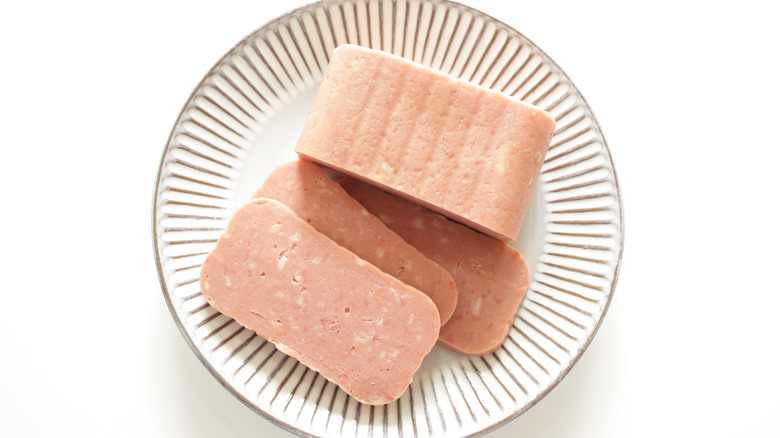How To Tell If Spam Has Gone Bad
Spam is one of the most recognizable canned meats on the market. In fact, in 2020, almost 60 million Americans purchased the luncheon ham, beating out dozens of other canned meats (via Statista). So with interest at an all-time high, now is as good a time to investigate shelf life and how to tell if your can of Spam has spoiled.
Despite not being particularly healthy or nutrient-rich, the canned meat is cheap and convenient and — dare we say it — delicious. Salty and somewhat peppery, Spam has a uniquely moist and almost spongy texture that's super versatile, making it a great companion when fried with eggs, diced into mac and cheese, or even packed neatly into musubi.
Introduced by Hormel Foods in 1937, Eater reports that Spam was created as a solution for wartime rations but grew in popularity, leading it to become the cult classic that it is today. Hormel Foods explains that the ingredients are mixed, added to cans, cooked, and cooled, made with ham, salt, water, potato starch, sugar, and sodium nitrite. Once labels are added to the cans of "spiced ham," the preserved meat is ready to make its way into your non-perishable pantry stockpile.
Avoid damaged cans and funky smelling Spam
Most shelf-stable foods can last indefinitely, but a time frame for quality is usually indicated on the labels of manufactured goods like Spam. This is why FoodSafety.Gov recommends consuming shelf-stable canned meats within five years if left in the pantry. However, once opened and kept in the fridge, this figure shrinks to about only four days.
How you store your Spam can also affect the shelf life. Before eating any canned goods, you should always inspect the container. Any indication of leaking or visible punctures means it should be tossed. According to Reader's Digest, denting (especially along the seam) can also be concerning as it could mean that pathogens have entered the recipient, putting you at risk of contracting botulism.
If the can is in mint condition, then the next step is evaluating the quality of the Spam. Odd aromas and appearances are the biggest indicators that the ham has spoiled. If the meat smells foul or looks dull, slimy, or moldy, Oven Via advises discarding immediately. While it goes without saying, a less than tasty bite can also mean it has passed its prime — let your senses be your guide!

